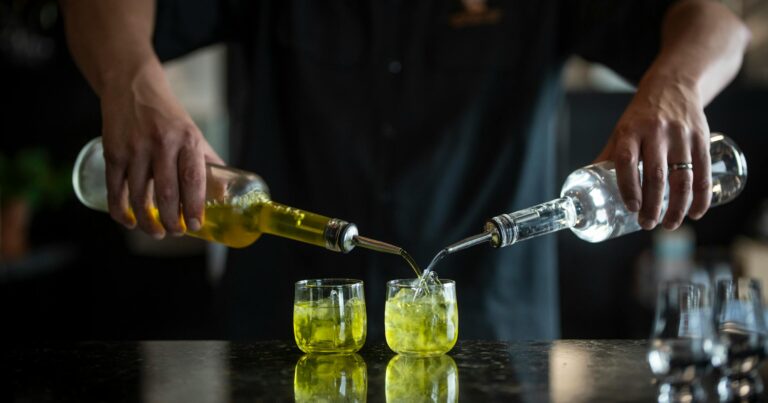BROOTEN, Minn. – When the folks at Redhead Creamery make their artisanal cheeses, they now think about alcohol. And for good reason.
When producing award-winning cheeses like Margie Cheddar and North Fork Whiskey Washed Munster, only 10 percent of the milk is processed into cheese. The rest is whey, a yellowish liquid that can be broken down into proteins (which can be fed to cows or sold commercially to humans) and sugar.
For the first time last week, the owners of Redhead Creamery turned that sugar into a spirit called araga, a clear liqueur that’s less harsh than whiskey, rye or even vodka.
“It tastes like vodka, but creamy. There’s a certain sweetness to it,” said Lucas Sjostrom, who runs the dairy with his wife, Alise, and her parents, Jerry and Linda Jennissen.
For centuries, people around the world have been creating alcohol by fermenting milk, but the process of distilling whey into a specialty liquor is fairly new, with a few whey-based spirits hitting the market in the last decade. These include Vodkow Vodka from Ontario, Wheyward Spirit from California, and Copper Crow from Bayfield, Wisconsin.
But the product remains incredibly rare: Industry experts estimate that there are fewer than two dozen distilleries worldwide that produce whey-based spirits. Sjostrom attributes this to the inefficiency of using whey compared to grains in making alcohol, and the lack of availability of whey for many distillers.
“You kind of have to have a cheese factory to get free whey,” said Sjostrom, 37. “But we have a source and we like to bring dairy to life.”
The dairy’s aragas and vodkas are now available for purchase in the venue’s tasting room, which also recently began serving burgers, cheeses and desserts. The cocktail menu features seven specialty drinks, many of them aragas-based, and all are topped with one of Redhead’s artisanal cheeses.
Decades of love for dairy products
The dairy owners’ love of all things dairy began decades ago. Jerry and Linda Jennissen met at a county calf show and, after marrying, moved to a farm just north of the current dairy in 1979. That first winter, they stumbled upon the dairy property while cross-country skiing.
“It was an abandoned property. They moved in just north of the dairy and said, ‘This would be a nice place to raise our family. This would be a nice place to raise cows,’” Sjostrom said. “They just thought it was so idyllic.”
The couple purchased 40 acres of the farm in 1983 and have since restored it to its original 300 acres.
Lucas and Alise also met through the dairy industry, at a Junior Holstein Association convention. They began dating at the University of Minnesota, where Lucas was majoring in animal science and Alise in dairy quality.
Alise, 38, also competed in the Princess Kay of the Milky Way pageant and was known to her friends as “Cheese Alise.”
“I had friends in high school who called me that,” she laughs. “They always made fun of me because I was always so pushy about drinking milk and eating cheese.”
Alise said she knew since high school that she wanted to one day open an artisan cheese business. While living in Vermont for a few years, Alise worked at Grafton Village Cheese Co. That convinced Lucas to join the venture.
“Within her first few weeks on the job, she sent cheese to George H.W. Bush, John Travolta, and the CEO of Disney/Pixar at the time. And I thought, ‘Oh, people buy this stuff,’” he said. “We didn’t have any friends. We didn’t have any kids. We didn’t have any family. So we started going to cheese companies and breweries every weekend and coming up with a business plan.”
In 2012, they returned to Minnesota to start a family and, soon after, a cottage cheese business. Lucas is also the executive director of the Minnesota Milk Producers Association, where he advocates on behalf of Midwest dairy farmers.
While Alise dreamed of starting a farmhouse cheese company, Lucas decided to add spirits to the mix. He said he first saw a story in 2011 about people turning whey into alcohol.
“At the time, I was probably drinking Busch Light and I probably didn’t know what spirits were,” he said. “But I think we can make as much money out of our cheese vat on the cheese side as we can on the spirits side.”
Over the past decade, Lucas has taken distilling classes and visited nearly 200 distilleries across the country.
“It’s a community like the cheese community,” he said. “If you say, ‘I’m going to be a distiller,’ they say, ‘Come back! Here’s everything I don’t tell on the tour.’ It was very helpful.”
The science behind it all
How does whey become araga? After the cheese making process, the remaining whey is filtered to separate the proteins from the sugar. Lactase is added to break down the sugar and yeast is added to convert the glucose into alcohol.
At this point in the process, the liquid is a “Mountain Dew yellow” color and tastes similar to a cider beer. This liquid is then heated through the distillation process. The final product contains approximately 40% alcohol.
“This is not a new technology by any means,” Lucas said. “But what they’ve discovered over the last 70 years is that the protein part is the valuable part.” [of whey] “We do the opposite. We say: let’s give protein to the cows and turn the sugar into alcohol.”
Redhead Creamery, 31535 463rd Ave., Brooten, Minnesota, redheadcreamery.comTasting room and cheese shop open 11am-4pm Thursday-Friday and 11am-5pm Saturday; farm tours available at 12:30pm Friday-Saturday.


